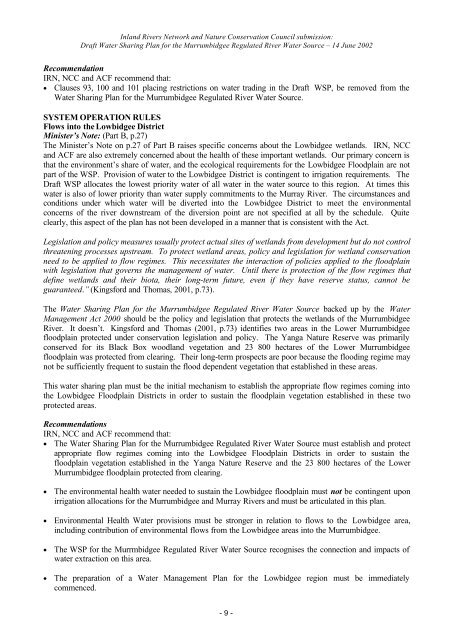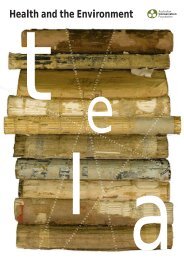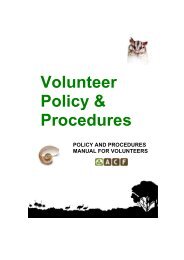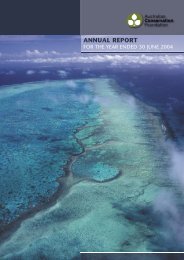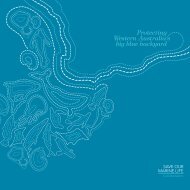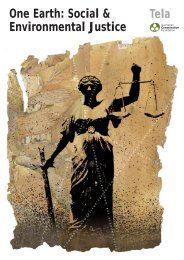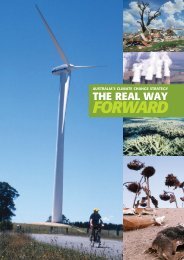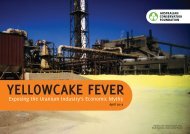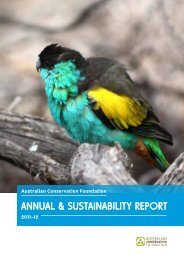Submission on Draft Water Sharing Plan for the Murrumbidgee River
Submission on Draft Water Sharing Plan for the Murrumbidgee River
Submission on Draft Water Sharing Plan for the Murrumbidgee River
You also want an ePaper? Increase the reach of your titles
YUMPU automatically turns print PDFs into web optimized ePapers that Google loves.
Inland <strong>River</strong>s Network and Nature C<strong>on</strong>servati<strong>on</strong> Council submissi<strong>on</strong>:<br />
<strong>Draft</strong> <strong>Water</strong> <strong>Sharing</strong> <strong>Plan</strong> <strong>for</strong> <strong>the</strong> <strong>Murrumbidgee</strong> Regulated <strong>River</strong> <strong>Water</strong> Source – 14 June 2002<br />
Recommendati<strong>on</strong><br />
IRN, NCC and ACF recommend that:<br />
• Clauses 93, 100 and 101 placing restricti<strong>on</strong>s <strong>on</strong> water trading in <strong>the</strong> <strong>Draft</strong> WSP, be removed from <strong>the</strong><br />
<strong>Water</strong> <strong>Sharing</strong> <strong>Plan</strong> <strong>for</strong> <strong>the</strong> <strong>Murrumbidgee</strong> Regulated <strong>River</strong> <strong>Water</strong> Source.<br />
SYSTEM OPERATION RULES<br />
Flows into <strong>the</strong> Lowbidgee District<br />
Minister’s Note: (Part B, p.27)<br />
The Minister’s Note <strong>on</strong> p.27 of Part B raises specific c<strong>on</strong>cerns about <strong>the</strong> Lowbidgee wetlands. IRN, NCC<br />
and ACF are also extremely c<strong>on</strong>cerned about <strong>the</strong> health of <strong>the</strong>se important wetlands. Our primary c<strong>on</strong>cern is<br />
that <strong>the</strong> envir<strong>on</strong>ment’s share of water, and <strong>the</strong> ecological requirements <strong>for</strong> <strong>the</strong> Lowbidgee Floodplain are not<br />
part of <strong>the</strong> WSP. Provisi<strong>on</strong> of water to <strong>the</strong> Lowbidgee District is c<strong>on</strong>tingent to irrigati<strong>on</strong> requirements. The<br />
<strong>Draft</strong> WSP allocates <strong>the</strong> lowest priority water of all water in <strong>the</strong> water source to this regi<strong>on</strong>. At times this<br />
water is also of lower priority than water supply commitments to <strong>the</strong> Murray <strong>River</strong>. The circumstances and<br />
c<strong>on</strong>diti<strong>on</strong>s under which water will be diverted into <strong>the</strong> Lowbidgee District to meet <strong>the</strong> envir<strong>on</strong>mental<br />
c<strong>on</strong>cerns of <strong>the</strong> river downstream of <strong>the</strong> diversi<strong>on</strong> point are not specified at all by <strong>the</strong> schedule. Quite<br />
clearly, this aspect of <strong>the</strong> plan has not been developed in a manner that is c<strong>on</strong>sistent with <strong>the</strong> Act.<br />
Legislati<strong>on</strong> and policy measures usually protect actual sites of wetlands from development but do not c<strong>on</strong>trol<br />
threatening processes upstream. To protect wetland areas, policy and legislati<strong>on</strong> <strong>for</strong> wetland c<strong>on</strong>servati<strong>on</strong><br />
need to be applied to flow regimes. This necessitates <strong>the</strong> interacti<strong>on</strong> of policies applied to <strong>the</strong> floodplain<br />
with legislati<strong>on</strong> that governs <strong>the</strong> management of water. Until <strong>the</strong>re is protecti<strong>on</strong> of <strong>the</strong> flow regimes that<br />
define wetlands and <strong>the</strong>ir biota, <strong>the</strong>ir l<strong>on</strong>g-term future, even if <strong>the</strong>y have reserve status, cannot be<br />
guaranteed.” (Kings<strong>for</strong>d and Thomas, 2001, p.73).<br />
The <strong>Water</strong> <strong>Sharing</strong> <strong>Plan</strong> <strong>for</strong> <strong>the</strong> <strong>Murrumbidgee</strong> Regulated <strong>River</strong> <strong>Water</strong> Source backed up by <strong>the</strong> <strong>Water</strong><br />
Management Act 2000 should be <strong>the</strong> policy and legislati<strong>on</strong> that protects <strong>the</strong> wetlands of <strong>the</strong> <strong>Murrumbidgee</strong><br />
<strong>River</strong>. It doesn’t. Kings<strong>for</strong>d and Thomas (2001, p.73) identifies two areas in <strong>the</strong> Lower <strong>Murrumbidgee</strong><br />
floodplain protected under c<strong>on</strong>servati<strong>on</strong> legislati<strong>on</strong> and policy. The Yanga Nature Reserve was primarily<br />
c<strong>on</strong>served <strong>for</strong> its Black Box woodland vegetati<strong>on</strong> and 23 800 hectares of <strong>the</strong> Lower <strong>Murrumbidgee</strong><br />
floodplain was protected from clearing. Their l<strong>on</strong>g-term prospects are poor because <strong>the</strong> flooding regime may<br />
not be sufficiently frequent to sustain <strong>the</strong> flood dependent vegetati<strong>on</strong> that established in <strong>the</strong>se areas.<br />
This water sharing plan must be <strong>the</strong> initial mechanism to establish <strong>the</strong> appropriate flow regimes coming into<br />
<strong>the</strong> Lowbidgee Floodplain Districts in order to sustain <strong>the</strong> floodplain vegetati<strong>on</strong> established in <strong>the</strong>se two<br />
protected areas.<br />
Recommendati<strong>on</strong>s<br />
IRN, NCC and ACF recommend that:<br />
• The <strong>Water</strong> <strong>Sharing</strong> <strong>Plan</strong> <strong>for</strong> <strong>the</strong> <strong>Murrumbidgee</strong> Regulated <strong>River</strong> <strong>Water</strong> Source must establish and protect<br />
appropriate flow regimes coming into <strong>the</strong> Lowbidgee Floodplain Districts in order to sustain <strong>the</strong><br />
floodplain vegetati<strong>on</strong> established in <strong>the</strong> Yanga Nature Reserve and <strong>the</strong> 23 800 hectares of <strong>the</strong> Lower<br />
<strong>Murrumbidgee</strong> floodplain protected from clearing.<br />
• The envir<strong>on</strong>mental health water needed to sustain <strong>the</strong> Lowbidgee floodplain must not be c<strong>on</strong>tingent up<strong>on</strong><br />
irrigati<strong>on</strong> allocati<strong>on</strong>s <strong>for</strong> <strong>the</strong> <strong>Murrumbidgee</strong> and Murray <strong>River</strong>s and must be articulated in this plan.<br />
• Envir<strong>on</strong>mental Health <strong>Water</strong> provisi<strong>on</strong>s must be str<strong>on</strong>ger in relati<strong>on</strong> to flows to <strong>the</strong> Lowbidgee area,<br />
including c<strong>on</strong>tributi<strong>on</strong> of envir<strong>on</strong>mental flows from <strong>the</strong> Lowbidgee areas into <strong>the</strong> <strong>Murrumbidgee</strong>.<br />
• The WSP <strong>for</strong> <strong>the</strong> Murrmbidgee Regulated <strong>River</strong> <strong>Water</strong> Source recognises <strong>the</strong> c<strong>on</strong>necti<strong>on</strong> and impacts of<br />
water extracti<strong>on</strong> <strong>on</strong> this area.<br />
• The preparati<strong>on</strong> of a <strong>Water</strong> Management <strong>Plan</strong> <strong>for</strong> <strong>the</strong> Lowbidgee regi<strong>on</strong> must be immediately<br />
commenced.<br />
- 9 -


